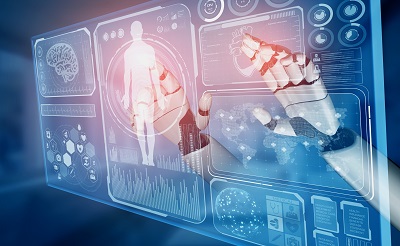The market for artificial intelligence (AI)—specifically, machine learning (ML) tools—in healthcare is expected to top $20 million in 2023. Various AI-aligned technologies, such as computer vision, natural language processing, and pattern recognition algorithms, are already deeply embedded in the healthcare ecosystem and will continue to be adopted as evidence of their usefulness grows. Some examples of areas where AI is used include drug discovery, where it can assist with predicting outcomes of clinical trials and potential side effects of new drugs, advanced research to bring new products to market quickly, and analysis of medical imagery, which involves using computer vision algorithms to spot early warning signs of disease in x-rays or MRI scans. It has also successfully been used to detect and treat neurological disorders, including Parkinson’s disease and Alzheimer’s disease. Further, it is helpful for analyzing data collected from patient wearables or in-home sensors to provide early warning or predictive diagnosis of various conditions. Beyond its applications in clinical work, AI performs clerical tasks, such as processing insurance claims and managing or analyzing medical records. AI also enhances the patient experience by facilitating appointment scheduling, intake processes, communication, and education.
The rush to be part of this new medical world
The speed with which AI in the medical industry continues to grow is driven by several factors, not the least of which was the COVID-19 pandemic, which shone a bright light on the need for better end-patient care when the industry was overwhelmed with critical care patients. Now, more than ever, any technology that can help identify disease markers or aid in pre-diagnoses is essential. From an operational standpoint, this new AI approach reduced lead times, with everything from booking appointments to patient response times, and also decreased overall costs for the industry by automating mundane tasks previously performed by humans.
Another growth factor can be attributed to the uptick in venture capitalists and biotechnology companies investing in AI technology, subsequently scaling those tools and techniques, and then applying them to the healthcare space. Investors are also working in partnership with manufacturers. For example, companies including Amazon, Microsoft, and Meta are just a few of the big technology giants that are actively working on making inroads in the healthcare industry.
With the advancement of technologies, these tools are now becoming smarter—the recent ChatGPT being one such example. Long-term, the application of ChatGPT in the healthcare space will overcome many human limitations, thereby allowing the industry to assist with everything from accessing vast databases to quickly discovering what medical information is required to facilitate patient diagnoses. This is possible because of AI accuracy, particularly when it comes to the interpretation of data. For example, AI can be leveraged to ensure a model used to analyze a brain scan is compared against previous historical diagnoses, enhancing its diagnostic efficacy.
The human factor
AI cannot do away with the very much-needed human aspect that patients naturally expect. In addition to meeting patient expectations, human and professional intervention is essential for validating the accuracy and/or interpretation of data dispensed by AI. Its accuracy is limited. Consequently, whoever is using these tools, whether for inpatient care or a diagnosis, needs to be aware of its limitations.
To ensure optimal outcomes and experiences for the patient and provider, it is essential that there is a symbiosis between humans and the AI tools being utilized. In a September 2022 podcast interview with Greylock, Dr. Fei-Fei Li, the co-director of Stanford’s Institute for Human-Centered Artificial Intelligence, noted, “AI is not one thing. Designing AI systems are really stages of work decisions, and…we need to infuse the ethics and human-centered values. Simplest way to put it, how do we define a problem? For example, is your goal to replace humans without consideration of all the social implications, or augment human capability?” Dr. Li says programmers and developers need to consider human values and one key question when developing code: “Does it assist the humans or inform the humans?”
That human/AI nexus is just as important in in robotic surgeries, which are minimally invasive and lower the risk of cross-contamination. For these surgeries to take place, they require a human behind them, overseeing the robot’s actions and ensuring that the training model and algorithms do not create any errors. The human factor is also essential for creating even smarter robotic tools based on the type of overall performance of its lifecycle.
Meeting the challenges
While AI in the healthcare industry opens an exciting world, the biggest challenges are ensuring that the technology is not misused, that it doesn’t violate HIPAA laws, and that it does not trigger the leak of confidential information. On the patient side, it’s imperative that AI doesn’t offer up an incorrect diagnosis—the ramifications of which could be disastrous. It’s critical to monitor AI continuously to make sure it optimizes outcomes, increases accuracy, and is always overseen by a human.
On the plus side, there is now a growing realization that trained professionals and support staff entering the healthcare industry need to have both the aptitude and the attitude to work with technology. Educational programs are rapidly adapting to meet that need. Just last month, Stamford Health in Connecticut began training nurses in the Metaverse by working on virtual patients via simulated medical conditions, utilizing the Oxford Medical Simulation program. “Our virtual reality, first and foremost, is intended to be something that is immersive and engaging,” said Stamford Health Center Simulation and Learning Manager Michelle Saglimbene. “A lot of our younger nurses are young millennials and Gen-Zers, so this type of technology is something that they’re familiar with in the gaming industry.” In addition, from a regulatory perspective, the FDA is recommending that AI healthcare support tools are regulated as medical devices, further supporting patient safety and outcomes.
The profitability factor
To fully embrace the power of AI, it is essential for healthcare organizations to redefine their parameters in terms of what profitability will look like. To remain efficient, they will need to identify AI-supported revenue streams and determine which expenses can be reduced, particularly with human staff. This will also require creating a plan for employees that are not adaptive to new technologies and are resistant to change.
By adopting AI technologies in the healthcare field, the Frost & Sullivan, a research and consulting firm, predicts that doing so could potentially save the industry over $150 billion by 2025, precisely because of the ability to automate much of the work that is needed. And a 2020 McKinsey Report noted that 15 percent out of a possible 35 percent of work hours throughout the industry is likely to be automated, with significant gains being achieved by 2030.
In light of the COVID-19 pandemic, it has become clear that AI has broad and positive implications for the healthcare industry. AI can reduce lead times, increase productivity, improve outcomes, and enhance the patient experience. This, in turn, will drive organizational profitability. In the long term, the sky is the limit for AI applications, particularly in its position at the forefront of lifesaving innovations in the diagnosis, treatment, and prevention of diseases.






















